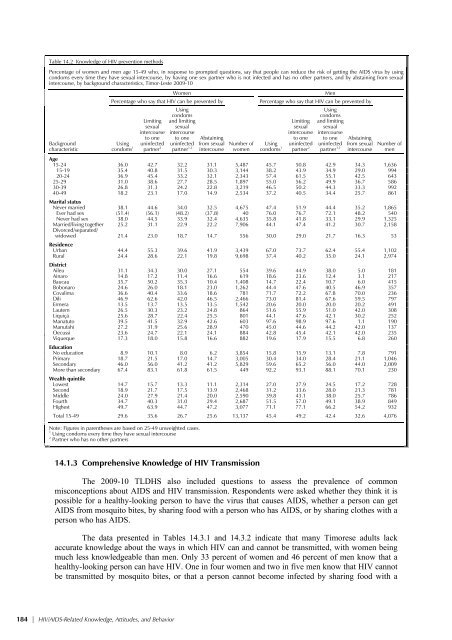Demographic and Health Survey 2009-10 - Timor-Leste Ministry of ...
Demographic and Health Survey 2009-10 - Timor-Leste Ministry of ...
Demographic and Health Survey 2009-10 - Timor-Leste Ministry of ...
You also want an ePaper? Increase the reach of your titles
YUMPU automatically turns print PDFs into web optimized ePapers that Google loves.
Table 14.2 Knowledge <strong>of</strong> HIV prevention methods<br />
Percentage <strong>of</strong> women <strong>and</strong> men age 15-49 who, in response to prompted questions, say that people can reduce the risk <strong>of</strong> getting the AIDS virus by using<br />
condoms every time they have sexual intercourse, by having one sex partner who is not infected <strong>and</strong> has no other partners, <strong>and</strong> by abstaining from sexual<br />
intercourse, by background characteristics, <strong>Timor</strong>-<strong>Leste</strong> <strong>2009</strong>-<strong>10</strong><br />
Background<br />
characteristic<br />
184 | HIV/AIDS-Related Knowledge, Attitudes, <strong>and</strong> Behavior<br />
Women Men<br />
Percentage who say that HIV can be prevented by<br />
Percentage who say that HIV can be prevented by<br />
Using<br />
Number <strong>of</strong><br />
condoms women<br />
1<br />
Limiting<br />
sexual<br />
intercourse<br />
to one<br />
uninfected<br />
partner 2<br />
Using<br />
condoms<br />
<strong>and</strong> limiting<br />
sexual<br />
intercourse<br />
to one<br />
uninfected<br />
partner 1,2<br />
Abstaining<br />
from sexual<br />
Using<br />
intercourse<br />
condoms 1<br />
Limiting<br />
sexual<br />
intercourse<br />
to one<br />
uninfected<br />
partner 2<br />
Using<br />
condoms<br />
<strong>and</strong> limiting<br />
sexual<br />
intercourse<br />
to one<br />
uninfected<br />
partner 1,2<br />
Abstaining<br />
from sexual<br />
intercourse<br />
Number <strong>of</strong><br />
men<br />
Age<br />
15-24 36.0 42.7 32.2 31.1 5,487 45.7 50.8 42.9 34.3 1,636<br />
15-19 35.4 40.8 31.5 30.3 3,144 38.2 43.9 34.9 29.0 994<br />
20-24 36.9 45.4 33.2 32.1 2,343 57.4 61.5 55.1 42.5 643<br />
25-29 31.0 38.6 27.7 28.5 1,897 55.0 56.2 49.9 36.7 586<br />
30-39 26.8 31.3 24.2 22.8 3,219 46.5 50.2 44.3 33.3 992<br />
40-49<br />
Marital status<br />
18.2 23.1 17.0 14.9 2,534 37.2 40.5 34.4 25.7 861<br />
Never married 38.1 44.6 34.0 32.5 4,675 47.4 51.9 44.4 35.2 1,865<br />
Ever had sex (51.4) (56.1) (48.2) (37.8) 40 76.0 76.7 72.1 48.2 540<br />
Never had sex 38.0 44.5 33.9 32.4 4,635 35.8 41.8 33.1 29.9 1,325<br />
Married/living together<br />
Divorced/separated/<br />
25.2 31.1 22.9 22.2 7,906 44.1 47.4 41.2 30.7 2,158<br />
widowed<br />
Residence<br />
21.4 23.0 18.7 14.7 556 30.0 29.0 21.7 16.3 53<br />
Urban 44.4 55.3 39.6 41.9 3,439 67.0 73.7 62.4 55.4 1,<strong>10</strong>2<br />
Rural<br />
District<br />
24.4 28.6 22.1 19.8 9,698 37.4 40.2 35.0 24.1 2,974<br />
Aileu 31.1 34.3 30.0 27.1 554 39.6 44.9 38.0 5.0 181<br />
Ainaro 14.8 17.2 11.4 16.6 619 18.6 23.6 12.4 3.1 217<br />
Baucau 35.7 50.2 35.3 <strong>10</strong>.4 1,408 14.7 22.4 <strong>10</strong>.7 6.0 415<br />
Bobonaro 24.6 26.0 18.1 23.0 1,262 44.4 47.6 40.5 46.9 357<br />
Covalima 36.6 40.4 33.6 18.6 781 71.7 72.2 67.8 70.0 236<br />
Dili 46.9 62.6 42.0 46.5 2,466 73.0 81.4 67.6 59.5 797<br />
Ermera 13.5 13.7 13.5 13.5 1,542 20.6 20.0 20.0 20.2 491<br />
Lautem 26.5 30.3 23.2 24.8 864 51.6 55.9 51.0 42.0 308<br />
Liquiçá 25.6 28.7 22.4 25.5 801 44.1 47.6 42.1 30.2 252<br />
Manatuto 39.5 41.5 32.9 42.6 603 97.6 98.9 97.6 1.1 190<br />
Manufahi 27.2 31.9 25.6 28.9 470 45.0 44.6 44.2 42.0 137<br />
Oecussi 23.6 24.7 22.1 24.1 884 42.8 45.4 42.1 42.0 235<br />
Viqueque<br />
Education<br />
17.3 18.0 15.8 16.6 882 19.6 17.9 15.5 6.8 260<br />
No education 8.9 <strong>10</strong>.1 8.0 6.2 3,854 15.8 15.9 13.1 7.8 791<br />
Primary 18.7 21.5 17.0 14.7 3,005 30.4 34.0 28.4 21.1 1,046<br />
Secondary 46.0 56.0 41.2 41.2 5,829 59.6 65.2 56.0 44.0 2,009<br />
More than secondary<br />
Wealth quintile<br />
67.4 83.1 61.8 61.5 449 92.2 93.1 88.1 70.1 230<br />
Lowest 14.7 15.7 13.3 11.1 2,314 27.0 27.9 24.5 17.2 728<br />
Second 18.9 21.7 17.5 13.9 2,468 31.2 33.6 28.0 21.3 781<br />
Middle 24.0 27.9 21.4 20.0 2,590 39.8 43.1 38.0 25.7 786<br />
Fourth 34.7 40.3 31.0 29.4 2,687 51.5 57.0 49.1 38.9 849<br />
Highest 49.7 63.9 44.7 47.2 3,077 71.1 77.1 66.2 54.2 932<br />
Total 15-49 29.6 35.6 26.7 25.6 13,137 45.4 49.2 42.4 32.6 4,076<br />
Note: Figures in parentheses are based on 25-49 unweighted cases.<br />
1 Using condoms every time they have sexual intercourse<br />
2 Partner who has no other partners<br />
14.1.3 Comprehensive Knowledge <strong>of</strong> HIV Transmission<br />
The <strong>2009</strong>-<strong>10</strong> TLDHS also included questions to assess the prevalence <strong>of</strong> common<br />
misconceptions about AIDS <strong>and</strong> HIV transmission. Respondents were asked whether they think it is<br />
possible for a healthy-looking person to have the virus that causes AIDS, whether a person can get<br />
AIDS from mosquito bites, by sharing food with a person who has AIDS, or by sharing clothes with a<br />
person who has AIDS.<br />
The data presented in Tables 14.3.1 <strong>and</strong> 14.3.2 indicate that many <strong>Timor</strong>ese adults lack<br />
accurate knowledge about the ways in which HIV can <strong>and</strong> cannot be transmitted, with women being<br />
much less knowledgeable than men. Only 33 percent <strong>of</strong> women <strong>and</strong> 46 percent <strong>of</strong> men know that a<br />
healthy-looking person can have HIV. One in four women <strong>and</strong> two in five men know that HIV cannot<br />
be transmitted by mosquito bites, or that a person cannot become infected by sharing food with a
















